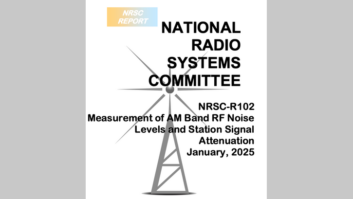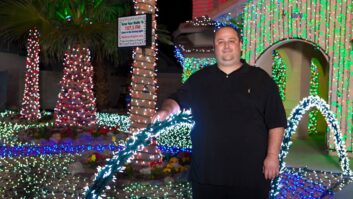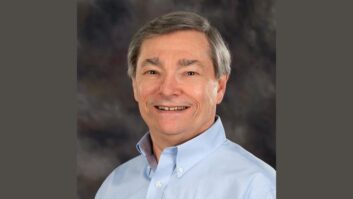TEMPE, Ariz. — Ralph Hogan has been around the broadcast engineering field long enough to have installed public radio’s first touchscreen master control facility at KSLU(FM) at Southeastern Louisiana University in 1984.
Hogan always has been quick to embrace new technologies. In fact, he’s been doing that at every stop throughout his 40-plus years in the industry.

New SBE President Ralph Hogan is shown in the terminal ops room KBAQ(FM) and KJZZ(FM) with a display of the Harris HDE-200 exporter. Photo by Annette Flores, KBAQ, KJZZ/Sun Sounds of Arizona
“My strength as an engineer is designing and building facilities and working with new technologies in doing so. I’ve worked on a number of technologies through my career. Some real leading-edge stuff,” Hogan said.
That background should serve him well in his role as new president of the Society of Broadcast Engineers. He hopes to pass that passion for adaptation and lifelong learning along to its membership through the release of at least one new certification level and other training opportunities in 2012.
Hogan, 63, succeeds Vincent Lopez as president of the organization; he began a one-year term at the SBE National Meeting in September. SBE is the professional organization of radio and television engineers and those in related fields; it has approximately 5,100 members and more than 100 chapters.
Hogan, CPBE, CBNT, DRB, is associate general manager for Tempe stations KJZZ(FM), KBAQ(FM) and Sun Sounds of Arizona. He has been active in many professional societies including the Institute of Electrical and Electronic Engineers. He was a founding member of the Association of Public Radio Engineers and recently stepped down as its president.
He sees his role as SBE president as carrying out the initiatives of the board and providing direction for the society for betterment of the membership.
“The board is elected by the membership and there to represent them and work with the executive leadership to run the organization. Our focus is on member benefit in everything we do.”
Continued education
The priorities of the current SBE board include the completion of a new strategic plan for the organization, the first update since 2006, said Hogan. He wrote about that in a commentary in the Nov. 16 Radio World.
“We’ve accomplished many of our goals and have just started piecing together some new points to focus on. Continued education and training for members will be a part of it,” he says.
To help formulate the next strategic plan, Hogan said SBE will invite its chapter chairs to attend a planning meeting next year.
Online courses and on-demand webinars will continue to be a focus of SBE University, the society’s online instruction tool, he said.
A new certification is expected to be introduced formally in 2012, according to Hogan. SBE hopes the Certified Broadcast Network Engineer (CBNE) will be available prior to the NAB Show next April, once a training module and proficiency exam are completed.
CBNE will be the equivalent to a five-year certification level, such as Certified Broadcast Radio Engineer or Certified Broadcast Networking Engineer, Hogan said.
“CBNE is a whole new certification that will delve deeper into networking and IT issues such as firewalls, routing tables, cloud computing and other topics permeating the broadcast technical environment.”

Knowledge of IT will continue to be a crucial as broadcast engineers are asked to manage computer networks, software and firmware. “Seems like every broadcast system and hardware has some sort of IT component. Whether it’s connected to a network or firmware, it’s become a necessity. Everything is software-supported now. The technology element is so critical because of its quick turnover rate.”
SBE’s legislative goals for 2012 include passage of a bill that would add a broadcast engineer to the staff of each FCC commissioner. Efforts fell short last year when the congressional session ended before any action was taken; the bills have been reintroduced in the current session as the FCC Technical Expertise Capacity Heightening Act, or the “FCC TECH Act” for short, S. 611 and H.R. 2102.
“We are getting bipartisan support. It’s moving through the system and we hope for passage in this Congress,” according to Hogan.
One reason to boost the “technical competence of policymaking” is the explosion of new technologies directly affecting the broadcast industry, Hogan says, which brings with it additional FM noise.
“Noise in all the bands is a serious issue. And as we add the technology that demands connectivity the noise floor will continue to grow,” Hogan said.
Technological breakthroughs have been good for most broadcast engineers in that engineers no longer are tied to their facilities, he feels.
“However, for all of us engineers it is getting more difficult to have time to ourselves. Unfortunately, in a way, technology has helped make our jobs 24/7, with even more responsibilities. Balancing work and personal time for (SBE) membership is more challenging than ever.”
Next-gen engineers
That time crunch also has meant fewer opportunities for mentoring of young broadcast engineers.
“As our headcounts have dwindled, we have lost very valuable years in mentorship within our industry. At one point there was an experienced technical operator who would mentor the more inexperienced staff at each station. That doesn’t happen anymore,” Hogan said. “We hope to work on the local level with our chapters to see more apprenticeship programs initiated.”
Hogan’s career began with a Bachelor of Science in engineering science from Louisiana State University in New Orleans. The Louisiana native made stops at several video production companies in that city before moving on to become chief communications engineer for KSLU(FM) at Southeastern Louisiana University, where he installed one of the first touchscreen master control facilities.
“It was 1986 and MediaTouch had just come out with a touchscreen automation system. It was one of the first on the market. I installed the third system they had sold.”
Hogan moved in 1990 to the Boise State University Radio Network as director of engineering and operations and was responsible for designing, installing and maintaining broadcast facilities, including transmission, microwave, uplink downlink and studios.
In 1998 he moved further west to Washington State University as assistant general manager of engineering services for the school, which included managing a total of some 40 radio and television sites in Washington, Idaho and Oregon.
While at Washington State, Hogan was one of four principal engineering investigators for the Advanced Digital Distribution Entity, a project funded by the Future Fund of the Corporation for Public Broadcasting.
“The project represented the public broadcast stations’ interests in developing a joint master control and digital distribution facility for the Northwest with possible implications for the next generation distribution system for PBS.
“The ADDE would capture centrally programming from PBS and other program providers. The ADDE would then aggregate customized program feeds.”
At Northwest Public Radio Hogan helped move many of the automation functions to Denver and used store and forward technology to deliver on-air underwriting messages to specific transmitter sites within the NWPR network.
KJZZ/KBAQ, licensed to Rio Salado College in Tempe, Ariz., has been Hogan’s workplace since 2008. There, he supervises a five-person engineering department and is responsible for operations and maintenance, facilities planning and systems integration for a radio system consisting of two radio transmitters, eight translators, five studios in three locations, a cable channel and a multichannel-capable digital satellite uplink.
Sun Sounds of Arizona is the school’s radio reading and information service; it airs on the 67 kHz subcarrier of KJZZ and on KBAQ HD3.
“The biggest challenge to radio reading services has been HD Radio,” Hogan said. “We made the decision to place our service on an HD channel, but there have been a lot of radio reading services eliminated as stations go HD and do multiple programming to utilize the full 200 kHz of spectrum.”







